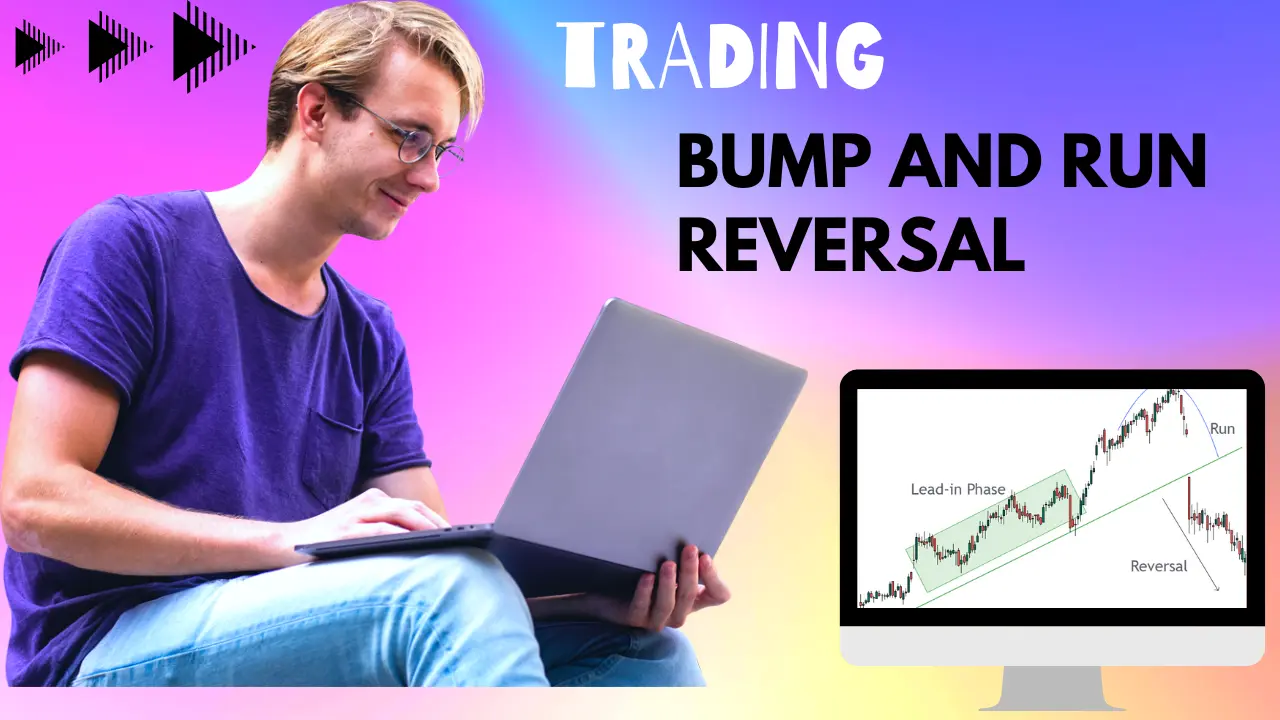The Bump and Run Reversal (BARR) is a short-term reversal pattern developed by Thomas Bulkowski. Bump and run reversal looks like a mountain range that forms during an uptrend and then is reversed by a downhill formation, resulting in a bearish reversal.
Bump and run reversals are fairly common and provide both investors and traders with a reliable reversal signal. Bump
and run reversal patterns are also important because their formation leaves an obvious smart money footprint.
In this article, we will not only learn about the pattern, but also how to identify bumps and reversals and trade them to make money.
Table of Contents
- How To Identify Bump and Run Reversal Pattern
- Psychology Behind Bump and Run Reversal pattern
- How To Trade Bump and Run Reversal Pattern
- Tips For Trading Bump and Run Reversal Patterns
- Conclusion
How To Identify Bump and Run Reversal Pattern

- Trendline
Before attempting to identify a possible bump and run reversal pattern, it is critical to draw a trend line connecting all possible swing lows. Trend lines are excellent for gathering trend information. BARR formation necessitates an upward sloping trendline with a slope ranging from 30 to 60 degrees, which is neither flat nor very steep.
- Lead- in Phase
The lead-in phase is a range-bound phase that occurs just before the bump phase and is characterized by the formation of small peaks not far from trend lines. Prices gather strength in this phase of development before the bump period begins. The lead-in phase can last one or two months, and peak heights are not very significant.
- Bump Phase
Bump phase usually starts with momentum breakout from lead-in consolidation and characterized by high volume, prices continue to incline and create a rounded bump. There may be small corrective formations between the bump formations, but they are usually insignificant.
Bump height is at least twice the height of the lead-in phase, and volume remains higher throughout the bump phase than the lead-in phase.
- Run Phase
Also called downhill phase, phase which creates the other part of mountain formation i.e the slope. It is a strong downtrend that may be strong enough to go straight to the trendline or may pause in between before finally touching the trendline.
Psychology Behind Bump and Run Reversal pattern
Bump and run reversal patterns are analogous to foothills and mountains in that the pattern is only visible once the mountains have fully formed and the downhill slope is visible.
Momentum is important in the formation of BARR; when momentum is low, prices tend to move near trendlines and volume and investor confidence is low; once momentum begins to build, prices tend to rise; with nice supporting structure at the bottom, prices eventually breakout from congestion and this opportunity is well received by smart money and large investors, and prices move higher with even more volume.
When supply and demand equilibrium is reached, volatility and volume tend to decrease, and there is a fear of losing market gains, prices pause and then begin to fall.
Smart money pulls out and prices begin to fall even more quickly, usually downtrend is more quick and sharp than upturned, prices in few weeks time reach near the trendline and foothill formation starts to develop, there is also a possibility of small bounce from the trendline but prices do not have left with the momentum to rise again this gives a fresh chance to bearish sentiments.
How To Trade Bump and Run Reversal Pattern

- Draw an uptrend line and confirm that the slope of the trendline is at least 30 degrees to the horizontal.
- Spot the Lead-in phase consolidation,calculate the height of bump, ensure that the height of bump is at least twice the height of lead-in peaks
- Wait for prices to fully cross the trendline from above.
- Draw a parallel trendline equal to the height of lead-in phase below the original trendline
- Wait for prices to go below this second trendline
- Take a short entry with stop loss above the parallel line.
- Price target should be at least 1:3 or thrice the height of lead-in phase.
Tips For Trading Bump and Run Reversal Patterns
Below tips will help you to give extra confluence to the bump and run reversal trading setup –
- Confirm the overall trend of the market, BARR perform well in bear market and this can be checked by looking at indices and how other stocks are performing.
- Height of the bump proves to be an important factor in the reliability of overall pattern, bump with height of more than twice are generally considered good for trading.
- Average formation length of this pattern is 4 to 6 months and should be kept in mind while trading.
- Patterns with volume high during bump formation and low during downhill run are better for long term reversal rate.
- Breakout from trendline with high volume and momentum is good signal for initiating a short position.
- Take a close look at RSI divergence, Bump and run reversal pattern along with RSI divergences are excellent trading signals.
Conclusion
Bump and run reversal is an essential price action phenomenon that occurs regularly during a bull run; learning how to play BARR may dramatically boost a price action trader’s odds of profitability. To trade BARR effectively first try to identify trendlines and practice trading candlesticks patterns with momentum and RSI , this will make a solid foundation for trading Bump and run reversal pattern.
Read More about BARR



![Read more about the article
<span class="bsf-rt-reading-time"><span class="bsf-rt-display-label" prefix="Reading Time"></span> <span class="bsf-rt-display-time" reading_time="6"></span> <span class="bsf-rt-display-postfix" postfix="mins"></span></span><!-- .bsf-rt-reading-time -->Fibonacci MACD Powerful & Profitable Strategy [2024]](https://bullsarenatrading.com/wp-content/uploads/2022/09/FIBONACCI-MACD-STRATEGY-300x225.webp)
![Read more about the article
<span class="bsf-rt-reading-time"><span class="bsf-rt-display-label" prefix="Reading Time"></span> <span class="bsf-rt-display-time" reading_time="7"></span> <span class="bsf-rt-display-postfix" postfix="mins"></span></span><!-- .bsf-rt-reading-time -->Best Intraday Strategy – Top 5 Day Trading Strategies [2024]](https://bullsarenatrading.com/wp-content/uploads/2022/09/5-BEST-INTRADAY-TRADING-STRATEGIES-300x225.webp)


